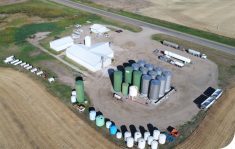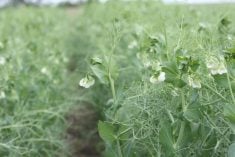SASKATOON – John Bielka is one farmer who’s not too concerned about the weather.
Conditions at his farm are wet all year round, every year.
Bielka manages a fish farm on Lake Diefenbaker, southwest of Saskatoon. While neighboring farmers watch the weather, Bielka keeps his eye on about 800,000 rainbow trout being grown for Canadian and American markets.
And while warm, sunny weather on the farm is nice, it’s the new half-million dollar expansion to the company’s processing plant that reeled in a claim of one of the largest freshwater fish farms in Canada.
Read Also

Volunteers help exotic animal farm rebuild
Exotic animal farm loses beloved camel and pony to huge hail storm that gripped the Brooks, Alta. area as a community member starts a fundraiser to help the family recover from the financial and emotional damage.
“We’re doing something in the middle of the Prairies that a lot of people thought couldn’t be done,” said Bielka, general manager of the AgPro Fish Farm at Lucky Lake, Sask.
The Saskatchewan Wheat Pool subsidiary needed to upgrade its processing plant after it broke into the U.S. seafood market with a $3.5-million contract expected to be signed shortly to provide 850,000 kilograms of trout to a Seattle company.
“It is very exciting,” Bielka said. He and other AgPro Grain representatives clinched the Seattle deal at a seafood trade show in San Francisco. Japan and other Pacific Rim countries were also interested in what the prairie fish farm is offering, he said.
“There is a huge market in Japan, where companies will pay a higher price for a better quality product,” said Ken Kuzminski, manager of AgPro’s processing plant.
Traditionally, AgPro sold most of its trout, about 225,000 kg last year, to restaurants and grocery stores in Montreal.
This year, production levels are up to 450,000 kg of fish and are expected to grow to one million kg next year as AgPro makes the jump into growing U.S. and Asian markets.
When the plant first opened in 1991, it produced 270 kg in the first year.
“I’ve been doing this since 1992 and have learned a lot since day one,” said Bielka.
That year he presented AgPro Grain officials with a joint-venture proposal to start a rainbow trout cage culture operation in Lake Diefenbaker. Before then, Bielka ran a hatchery producing arctic char fingerlings for AgPro’s Winnipeg operation.
The plant’s biggest competition comes from fish farms in Chile. Closer to home, AgPro runs head to head with two Ontario fish farms situated on the Great Lakes.
Completed in September following a four-month shutdown, the Saskatchewan processing plant was expanded by almost five times to create a working space of 3,500 square feet.
At harvest time, the fish are caught in small nets, transferred to a barge, electrocuted and then taken to the plant in ice-filled barrels.
New automation introduced when the plant was expanded hasn’t meant lost jobs, Kuzminski said, and more workers will probably be added to the 24-person staff in place now.
“The automation cuts down on the lifting and manual labor that had to be done before,” Kuzminski said.
For example, the plant now uses a hydraulic fish bucket for dumping, a head-cutting machine, a pin-boner to remove tiny bones from the fillets, a mechanical scale and a new $130,000 filleting machine which uses a mechanical eye to separate the fish in two and remove the ribs.
Heavy production
Running at full capacity, the plant can now process about 4,535 kg of fillets per day. It operates year round, with the exception of a month-long shutdown during the winter freeze-up and spring thaw. Workers drive over the ice to maintain the cages and monitor stocks throughout the winter.
For the first time this winter, 26 new cages, about 15 m in length, width and height and containing 20,000 fish each, will be submersed for one week during the freeze and thaw periods to prevent equipment damage and added stress to the fish.
















